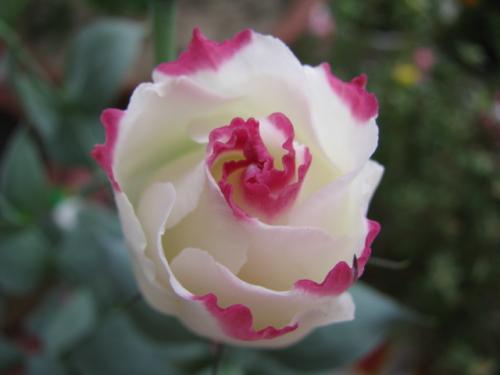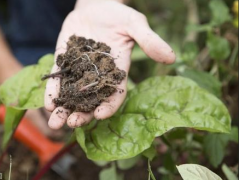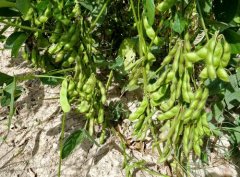Introduction of planting and cultivation methods and growing environment of Eustoma grandiflorum, vernalization and harvesting of Eustoma grandiflorum
Platycodon grandiflorum originated in North America called Texas Bluebell (Texas blue-bell). Cultivated and improved by horticulturists, Platycodon grandiflorum is now popular all over the world and is among the top ten in the Dutch auction market. Its wide variety of flowers and colors from dark purple blue, rose, pink, white to two-color series, petals have single, double. Cultivation is divided into early species, mesophytic species and late species. Apart from cut flowers, Platycodon grandiflorum is also used as potted flowers and flower bed plants. Platycodon grandiflorum was first introduced to Taiwan for cultivation in Puli in the mid-1970s, but because it did not fully understand the growth and flowering habits, the seedling stage was long and the production was unstable. In recent years, the production situation has gradually improved. Platycodon grandiflorum is a new cut flower crop, which has been cultivated in villages and towns in central and southern China, and its area is also increasing one after another. However, because the florists do not know much about the variety characteristics and seedling sources of Platycodon grandiflorum, the cultivation process is beset with difficulties, and the probability of failure is still very high.
Growing environment
Platycodon grandiflorum can be planted in windproof, rain-proof simple greenhouse or more sophisticated environmental regulation greenhouse, or even open-air cultivation. The most suitable temperature for cultivation of Platycodon grandiflorum is above 15 ℃. In order to maintain the best quality, the daytime temperature should be below 25 ℃. Nevertheless, Platycodon grandiflorum plants can tolerate higher temperatures. Under suitable climatic conditions, open-air cultivation is a feasible method. Its facilities provide only movable covering plastic sheets to prevent flowering plants from being destroyed when it rains. However, in the production of Platycodon grandiflorum under full sunlight, the length of the same variety is 60% longer than that of plants in greenhouse or with external shade. At present, most of Platycodon grandiflorum grown in Taiwan use tunnel plastic cloth chamber, which is still insufficient in winter, and the temperature is often more than 30 ℃ in summer. Therefore, there is room for improvement in the facilities for growing Platycodon grandiflorum in Taiwan.
Cultivation method
Soil preparation: the pH value of soil in Platycodon grandiflorum cultivation is between 6.3 and 7.0, which is higher than that of general flowers. at the same time, the content of soil calcium is higher, phosphate fertilizer should be enough to adjust pH value, increase calcium content and application of phosphate fertilizer should be used in soil preparation. When preparing the soil, we should fully plough and loosen the soil to avoid the hard layer at the bottom and affect the root growth of Platycodon grandiflorum. Soil diseases such as Fusarium wilt and blight are common, especially in soils with frequent continuous cropping. During soil preparation, steam or methane bromide (methyl bromide) can be used to disinfect, or biological control methods such as adding organic fertilizer can be used to accelerate the reproduction of soil microorganisms and reduce the occurrence of diseases.
Build beds: after land preparation, the width of the beds should be matched with the specifications of covering non-woven cloth, drip irrigation and anti-toppling netting. There are two kinds of anti-toppling net specifications: 15cm × 15cm and 15x20cm. Double-layer net frames are often used to produce high-quality cut flowers of Platycodon grandiflorum. The cultivation density is in line with the specifications of anti-toppling net, light intensity and utilization function. Usually, when the outdoor noon exceeds 65000lux, it is regarded as strong light, and the light intensity is the most appropriate in 32000~65000lux, while the light is insufficient below 32000lux. Taiwan can make its own choice because of the seasonal influence on light intensity. The recommended planting density is 84 plants / square meter or more in summer or high light, and 64 plants / square meter in winter or low light.
Raising seedlings: the seeds of Platycodon grandiflorum are very small and about 19000 / g (non-precipitated), with high seedling technology and good equipment. at present, Taiwan operators all buy Platycodon grandiflorum seedlings from professional seedlings or import seedlings from traders to pay attention to their quality. any damage at the seedling stage may affect the quality of the flower stem at maturity. The seedlings should be planted before the roots are wound. Do not hurt the roots or use aged seedlings to avoid delayed growth or failure during cultivation. Do not plant deeper than the original pot seedlings and prevent lodging and disease. Most people think that the cultivation of Platycodon grandiflorum seedlings is the most difficult, so they are planted by purchasing professional seedlings. The following are some points that should be paid attention to when raising seedlings in Platycodon grandiflorum.
1. The germination temperature is between 22-24 ℃, do not exceed 28 ℃, otherwise it will lead to clustering (rosette).
two。 Keep the humidity close to 100% and dissolve the seed wrap with enough water.
3. High contents of calcium and nitrate nitrogen were maintained in the seedling medium.
4. The seedling medium pH was kept above 5.8.
5. The seedling raising period depends on the variety, and the Taiwan climate can be completed in 8-10 weeks.
Fertilizer cultivation: in order to grow Platycodon grandiflorum well, the soil nutrient content must be sufficient. Some growers apply slow-acting fertilizer that can be maintained for 3 months after planting, while others use liquid fertilizer at the beginning (must reach 15, 1000 times liquid). Generally speaking, nitrogen fertilizer should be mainly in the form of nitrate nitrogen, and the content of potassium should be equal to that of nitrogen. Regardless of drip irrigation or spray irrigation, the concentration of nitrogen and potassium in each irrigation is 200ppm. Unless the soil maintains a high content of calcium during production, it should be replenished at any time. Calcium content is best supplemented with calcium nitrate solution.
Irrigation:. The irrigation of Platycodon grandiflorum should be careful because excessive irrigation will increase the infection rate of soil diseases, and if excessive drought will lead to delayed flowering, the short and thin quality of flowering stems will usually reduce the water demand of plants at low temperature and low light. Most growers use spray irrigation at the beginning of planting, and the drip irrigation method is not changed until the plant root goes deep into the planting bed. Spray irrigation has better effect on plants under high temperature and high light, and increasing humidity in greenhouse under high temperature and high light can promote the stem growth of Platycodon grandiflorum, but spray irrigation should be avoided after bud formation to reduce humidity to maintain flowering quality.
Electric light: the cultivation of Platycodon grandiflorum varies with varieties, and its cultivation period and flowering quality are affected by light intensity. Sufficient experience has been gained on the adjustment of sunshine length effect discussed by Platycodon grandiflorum growers, that is, in a low-light environment, supplementary light can promote flower stem elongation and flowering induction. Usually growers are used to taking the length of 16 hours of sunshine. The 150Watt white light bulb is spaced 3 meters apart and the row spacing is 4.5 meters in the greenhouse facility.
Picking flower bud: the experiment shows that electric treatment can improve plant growth and cut flower quality. Platycodon grandiflorum can delay harvest and adjust the market supply period for 1-2 weeks. Japanese Tsukada (1991) pointed out that long-day treatment can promote flower bud differentiation, increase the number of flower bracts and Internode length, improve the quality of cut flowers, and bloom earlier. On the contrary, the summer planting of cut flowers in spring and summer cultivation of cut flowers in autumn quickly changed from vegetative growth to reproductive growth because of the long-day high temperature in summer, after planting or after the first cut flowers. 30 days of short-day treatment (day length 9 hours) can promote the increase of node number, branch number, in order to improve quality and yield. The experimental results from 1991 to 1992 show that Platycodon grandiflorum is easy to fall into the growth obstacle and enter the cluster phenomenon under the condition of low temperature in winter or high temperature in summer. The moderate dormancy or growth period of Platycodon grandiflorum reached 90 days, which could improve the quality of cut flowers. Because of high temperature and humidity, serious diseases and insect pests, thin pedicels and poor quality in summer. Therefore, it is suggested that Platycodon grandiflorum should choose the most suitable temperature for growth (about 20-25 ℃), that is, March and October each year is the most suitable planting period (flat land in Tainan).
Vernalization treatment:. The seedling period of Platycodon grandiflorum was 70 days from sowing to planting, and 69 days from 30 days of low temperature treatment to the first flowering day. The spring experiment of 21 days of flowering period began to raise seedlings in the low temperature period (December ~ February), but it was suitable for temperature return in the field from March to April, when Platycodon grandiflorum began to grow. From May to June, the temperature increased rapidly and the plant grew rapidly. Therefore, it takes 69 days to 90 days from growth to flowering. The result is consistent with the expectation, that is, the effect of low temperature treatment is not good in the low temperature period. In previous years, seedlings were raised in the high temperature period from May to July and planted in the field from July to September. After planting, the plants entered the dormant cluster biochemical phenomenon because of the high temperature barrier, and the growth must not resume until April to May of the next year. The experiment of low temperature treatment of seedlings in the high temperature period (May to July) showed that the biochemical phenomenon of dormancy could be broken with the different low temperature demand of varieties.
Harvest
Platycodon grandiflorum is harvested when one or more buds are opened (3 are sold domestically in Taiwan). Platycodon grandiflorum growers often pick the first flower and the second flower before harvest so that they can get more flowers on the same pedicel. In Taiwan and Japan, cut Platycodon grandiflorum is sold in 10 bunches on the market. Some markets require the use of casing, while Taiwan currently uses vertical container transportation. The cut flower of Platycodon grandiflorum is not sensitive to ethylene, and the vase life can be prolonged by using 10% sugar solution for 24 hours after harvest. The field heat should be removed before harvest is carried out in the morning to ensure the quality. The cultivation period of Platycodon grandiflorum varies from planting to harvest according to the variety and environment, which usually takes 15 weeks under low light and low temperature, and 12 weeks under high light and suitable temperature. However, it takes a lower temperature and a longer time to produce high-quality cut flowers.

- Prev

The utilization of agricultural waste and the drying of livestock manure as a processing fertilizer have a good impact on the environment.
According to the "categories and specifications of fertilizers", if livestock manure is to be used as fertilizer, it can only be used as livestock manure composting, general composting or miscellaneous composting. Chen Junji, vice chairman of the Council of Agriculture, reported at the Social Welfare and Health and Environment Committee of the Legislative Yuan on the 29th.
- Next

Plant characters of New legume Green manure crop varieties Green manure Soybean Tainan 4 and Tainan 4
The new green manure soybean variety Tainan No. 4 in Tainan agricultural improvement farm was selected by a single plant. It has the characteristics of small grain, rapid growth, high fresh grass and fertilizer content, and long covering period. It is suitable for green manure cultivation in spring and summer and seed collection in autumn.
Related
- A course of planting techniques and methods on how to grow carrots
- How to plant the latest tulips?
- Is it better to pick tea in the morning or in the afternoon? When is the best time for tea to be picked? what is the third or fifth tea?
- Launch Yuanxiao Happy combination Haocha + Tea Yuan healthy Taste
- Penghu Tourism "Fireworks 20 Parade with You"
- 2022 West Lake Happiness holds "Digital Revitalization Voucher" and draws iphone13 and laptop.
- Banqiao Fuzhou social houses are designed to change start-up combined with police elimination to create a safe and livable environment
- The convenient measure of "mechanical weeding" in Xinbei has been abused and the Agriculture Bureau has imposed heavy penalties on the illegal land consolidation.
- Changgeng University Joins Hands with Four Memory Factories to Rescue Memory Talent Shortage
- The list of Taiwan's top 100 MVP managers is listed by the Director-General of the Farmers' Association of Sanxia District.

